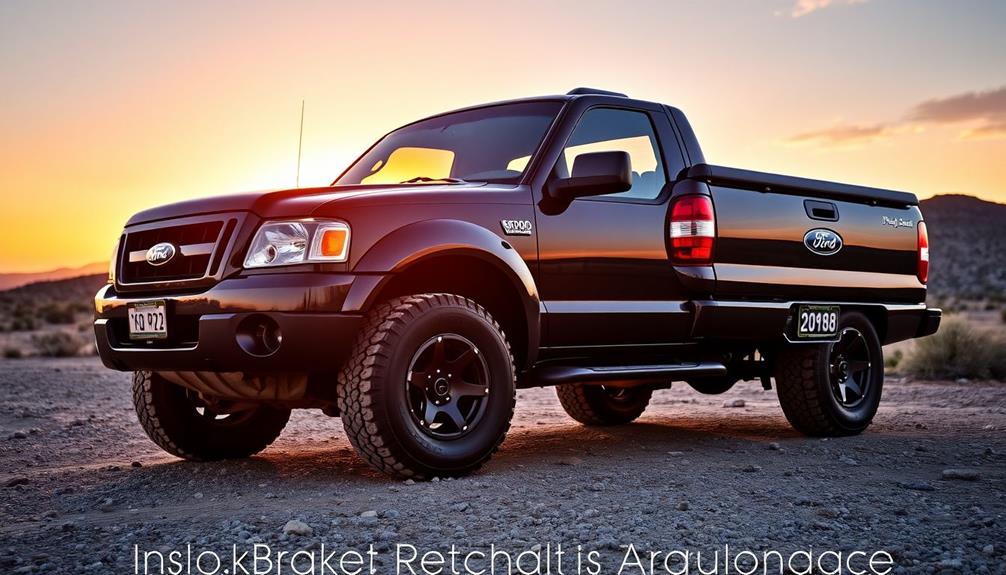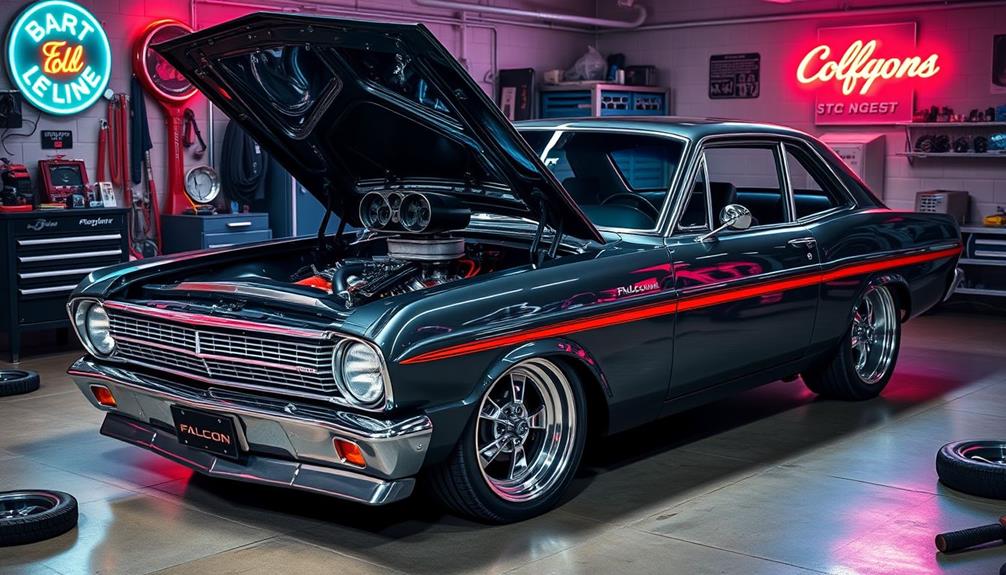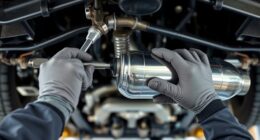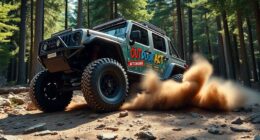Tuning your 2010 Ford Ranger can seriously enhance its power and performance while keeping it reliable. Start with tools like the X-cal 2 tuner or Lasota Racing for custom adjustments. Don't overlook the benefits of modifying engine timing and fuel maps, along with raising the speed limiter. Enhancements like a custom throttle body, cat-back exhaust, and upgraded gears can improve acceleration without breaking the bank. Also, consider using a wideband A/F meter to monitor air-fuel ratios during adjustments. Discover how all these tuning options can transform your pickup into a more powerful machine.
Key Takeaways
- Upgrade to an X-cal 2 Tuner or SCT tools for comprehensive engine and transmission adjustments to enhance performance.
- Implement a custom throttle body and cat-back exhaust system to improve airflow and engine response effectively.
- Modify your gear ratio to 3.73 for better acceleration without significant investment.
- Utilize a wideband A/F meter for accurate air-fuel ratio monitoring during performance tuning.
- Consider a V8 engine swap for substantial power gains, keeping emissions compliance in mind.
Tuning Recommendations and Tools
When tuning your 2010 Ford Ranger, it's vital to choose the right tools and recommendations to guarantee peak performance. A highly regarded option for performance enhancements is the X-cal 2 tuner. This tool not only provides excellent value but also caters specifically to Ford vehicles like yours.
For custom tuning needs, consider Lasota Racing; their responsive service and extensive knowledge of SCT products will guarantee you get the most out of your tuning experience.
Pro Racer Software offers three levels of tuning access—Consumer, Tuner, and SCT—allowing you to pick the level that fits your expertise. While SCT tools enable adjustments to engine and transmission parameters, remember they won't access ABS and Restraints parameters in the PCM, so be aware of these limitations.
To achieve ideal tuning outcomes, it's important to utilize a wideband A/F meter and datalogging. Monitoring air-fuel ratios accurately during performance adjustments can make a significant difference in your Ranger's performance.
Speed Limiter Adjustments
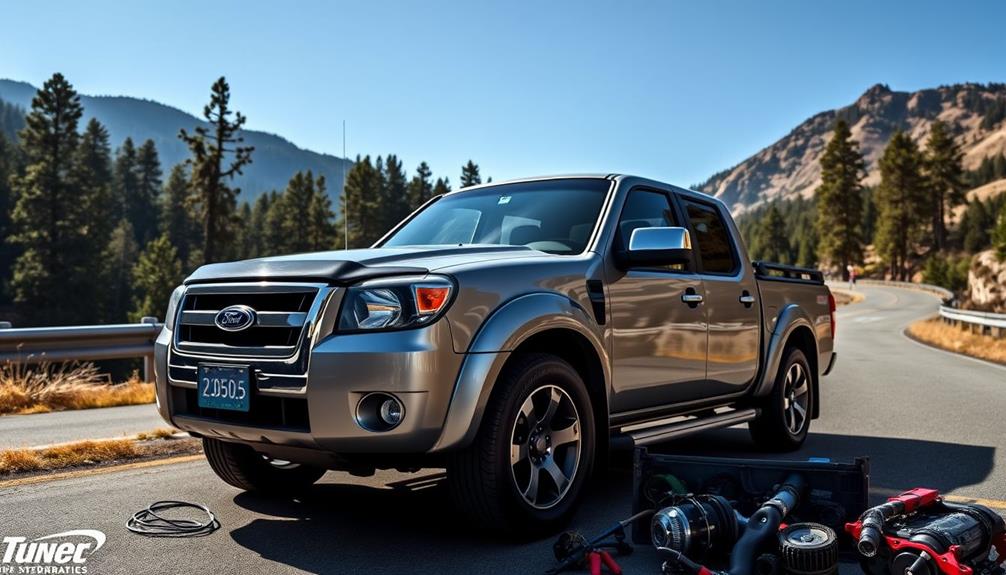
When you adjust the speed limiter on your 2010 Ford Ranger, you're releasing its true potential.
By understanding how the limiter functions, you can achieve smoother acceleration and improved performance.
Let's explore the benefits of these adjustments and how they can enhance your driving experience.
Speed Limiter Functionality Explained
Understanding the speed limiter functionality in your 2010 Ford Ranger is essential for optimizing performance and drivability. The speed limiter is designed to manage your truck's maximum speed, which can be adjusted starting from 65 mph. By properly calibrating this feature, you can enhance your driving experience considerably.
Here are some key points to take into account:
- Older models may cut fuel to all injectors when reaching the limit, causing abrupt performance changes.
- Custom tuning allows you to disable the speed limiter, releasing your Ranger's full potential.
- Adjustments can improve acceleration and deceleration shifts, making your drive smoother.
- The speed limiter settings also influence transmission behavior, including shift firmness and throttle response.
- A well-calibrated speed limiter can lead to a more engaging driving experience.
Performance Gains From Adjustments
Adjusting your 2010 Ford Ranger's speed limiter can lead to significant performance gains that enhance your driving experience. By fine-tuning the speed limiters, you can achieve smoother acceleration and higher top speeds, which can be especially beneficial when merging onto highways or steering through hilly terrain. Typically, these limiters are set between 65 mph and higher, depending on your model's configuration.
Proper calibration of speed limiters improves drivability and responsiveness during acceleration, particularly in models with electronic throttle controls. While newer Ford models manage power reduction in stages, older versions cut fuel to all injectors simultaneously, making these adjustments essential for peak performance.
Disabling or adjusting the speed limiter can release your engine's full potential. This change allows for firmer shifts and enhanced throttle response, contributing to better overall driving dynamics.
With custom tuning options available through devices like SCT tuners, you can tailor your Ranger's performance to fit your specific driving needs and preferences. Whether you're looking to improve daily driving or boost performance for off-road adventures, adjusting the speed limiter is an effective way to maximize your pickup's capabilities.
Engine and Transmission Tuning

Engine and transmission tuning for the 2010 Ford Ranger can greatly enhance your driving experience by boosting horsepower and improving acceleration. By focusing on these tuning aspects, you can optimize your Ranger's performance and make every drive more enjoyable.
Here are some key components to evaluate:
- Engine tuning: Modify timing, fuel maps, and EGR settings to increase horsepower and torque, especially with aftermarket components like cold air intakes or exhaust systems.
- Transmission tuning: Adjust shift points and torque converter lock-up for firmer gear changes and improved throttle response.
- SCT tuners: Use these devices for extensive access to engine and transmission parameters, allowing for customized adjustments.
- Speed limiter adjustments: Raise the speed limiter for better performance during acceleration and highway driving.
- Data logging: Utilize wideband A/F meters to monitor and adjust the air-fuel ratio, maximizing efficiency and performance.
Performance Enhancements

When it comes to boosting your 2010 Ford Ranger's performance, engine modifications play a vital role.
You've got various tuning tools and options at your disposal to fine-tune your vehicle's capabilities.
Let's explore how these enhancements can transform your driving experience.
Engine Modifications Overview
If you're looking to boost the performance of your 2010 Ford Ranger, there are several effective engine modifications to contemplate.
These upgrades can provide extra power and enhance your truck's overall drivability, making it more enjoyable to drive. Here are some modifications that you should consider:
- Custom throttle body (67mm from CFM): Increases airflow for better engine response.
- Cat-back exhaust systems: Brands like Gibson and Dynomax enhance exhaust flow and sound.
- Upgraded 3.73 gears: Improves acceleration and overall performance, a cost-effective choice.
- Aftermarket headers from MSDSinc: Boosts horsepower by improving exhaust flow and reducing back pressure.
- Nitrous oxide injection system: Offers considerable horsepower gains without exceeding stock fuel limits.
These engine modifications can greatly impact your Ford Ranger's performance, making it not just a reliable pickup, but a powerful one too.
Whether you're after improved acceleration or enhanced cooling efficiency, these options are worth considering to release your Ranger's true potential.
Tuning Tools and Options
For enhancing your 2010 Ford Ranger's performance, having the right tuning tools and options is vital. The X-cal 2 tuner is highly recommended for providing excellent value and effective tuning capabilities. It allows you to make significant performance adjustments that can improve your truck's overall efficiency and power.
If you're looking for a more tailored experience, SCT Pro Racer Software offers three access levels—Consumer, Tuner, and SCT—so you can choose based on your expertise. This flexibility enables you to customize your tuning approach effectively.
To guarantee your adjustments are safe and productive, utilize a wideband A/F meter and datalogging tools. These tuning tools are essential for monitoring air-fuel ratios and making certain you don't exceed safe limits during tuning.
For those interested in custom tuning, options like Lasota Racing provide responsive service and quality results. Their expertise can help you maximize your Ranger's potential by recalibrating fuel tables and EGR settings for peak performance.
Investing in the right tuning tools and custom tuning options will guarantee your pickup not only runs smoothly but performs at its best.
Cost-Effective Modifications
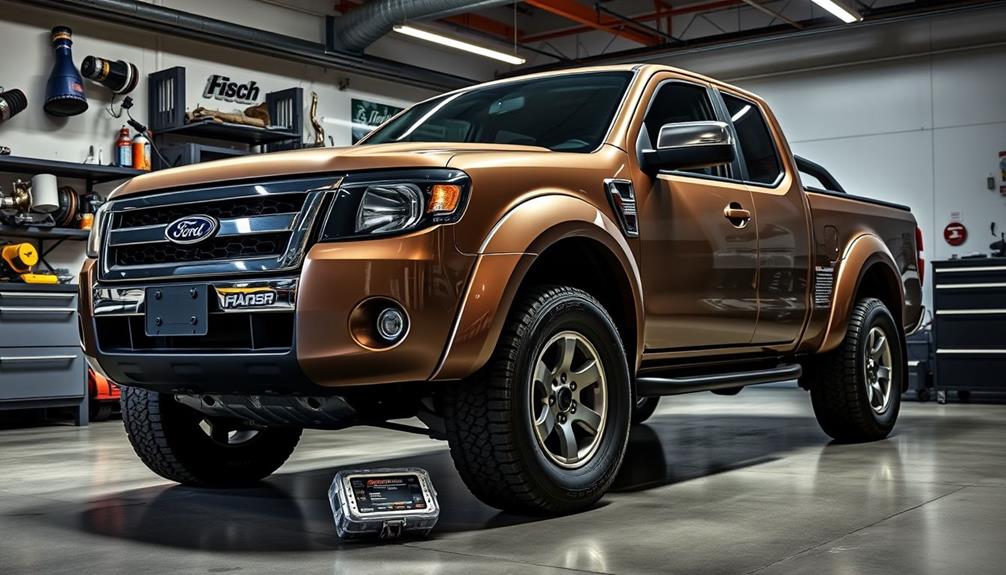
Cost-effective modifications for your 2010 Ford Ranger can elevate performance without breaking the bank.
These enhancements can improve your truck's overall driving experience while keeping your budget in check. Here are some top options to take into account:
- Custom Throttle Body: Upgrading to a 67mm throttle body from CFM boosts airflow and engine responsiveness.
- Cat-Back Exhaust System: Installing a system from Gibson or Dynomax enhances exhaust flow and gives your Ranger a more aggressive performance profile.
- Gear Swaps: Moving to 3.73 gears can greatly improve acceleration and power delivery, making your drives more engaging.
- Jet Performance Power Chip: This plug-and-play solution provides immediate power gains without the hassle of complex installations.
- Local Ranger Forums: Engage with others in the community for insights on cost-effective modifications and access to affordable parts from junkyards or donor vehicles.
Alternative Engine Options
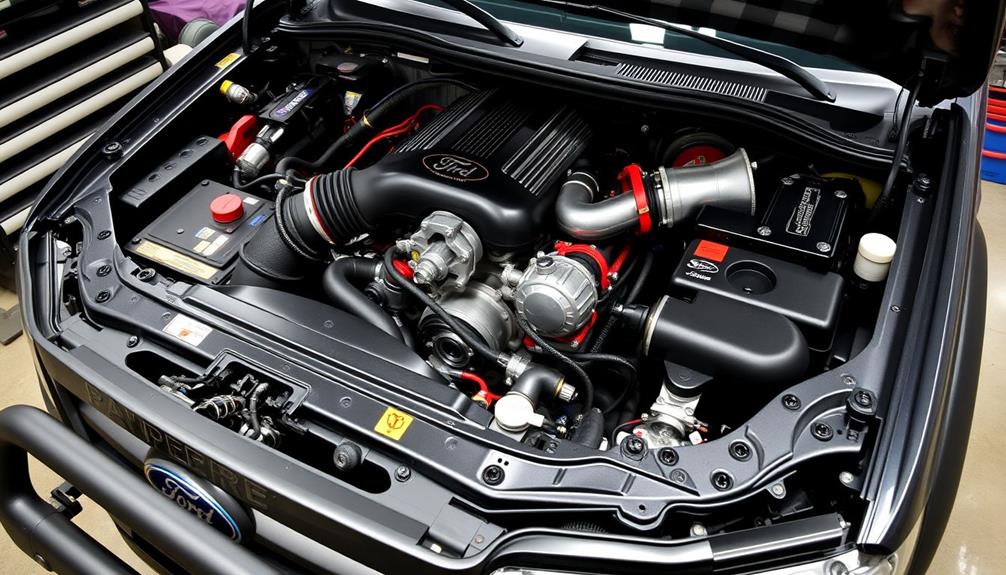
Exploring alternative engine options for your 2010 Ford Ranger can reveal a world of increased power and performance. One popular choice is a V8 engine swap, which can dramatically boost your power output. However, keep in mind that this option might complicate emissions compliance and inflate installation costs.
If you prefer to stick with the stock engine, consider upgrading to a 2.5L Duratec block. This can give you approximately 175 hp and 172 lb-ft of torque, enhancing your ride's performance. Additionally, forced induction systems like turbochargers can be adapted to the factory Duratec 2.3L engine, offering you substantial power gains while keeping engine reliability intact.
Here's a quick overview of your options:
| Engine Option | Power Output |
|---|---|
| V8 Engine Swap | Significant power increase |
| 2.5L Duratec Upgrade | 175 hp, 172 lb-ft torque |
| Turbocharged 2.3L | Major power boost |
| Supercharger for 2.3L | Increased hp and torque |
| Aftermarket Performance Parts | Optimized performance |
Each option has its benefits, so weigh your choices carefully to maximize your Ranger's potential.
Performance Testing Methods

How can you truly gauge the performance enhancements of your 2010 Ford Ranger after tuning?
You need to employ effective performance testing methods to see the real differences. Here are some key approaches you should consider:
- Dyno Testing: Measure horsepower and torque at the wheels under controlled conditions for accurate power gain data.
- Data Logging: Monitor engine parameters like air-fuel ratio, RPM, and throttle position during test drives to assess tuning adjustments.
- Acceleration Testing: Use a GPS-based performance meter to measure 0-60 mph and quarter-mile times, revealing tuning's impact on acceleration.
- Fuel Economy Testing: Track fuel consumption over a set distance before and after tuning to quantify improvements in miles per gallon (MPG) and overall efficiency.
- Comparative Testing: Compare your Ranger's performance against baseline metrics, established through previous runs or manufacturer specifications, to highlight gains from tuning modifications.
Installation Process and Considerations
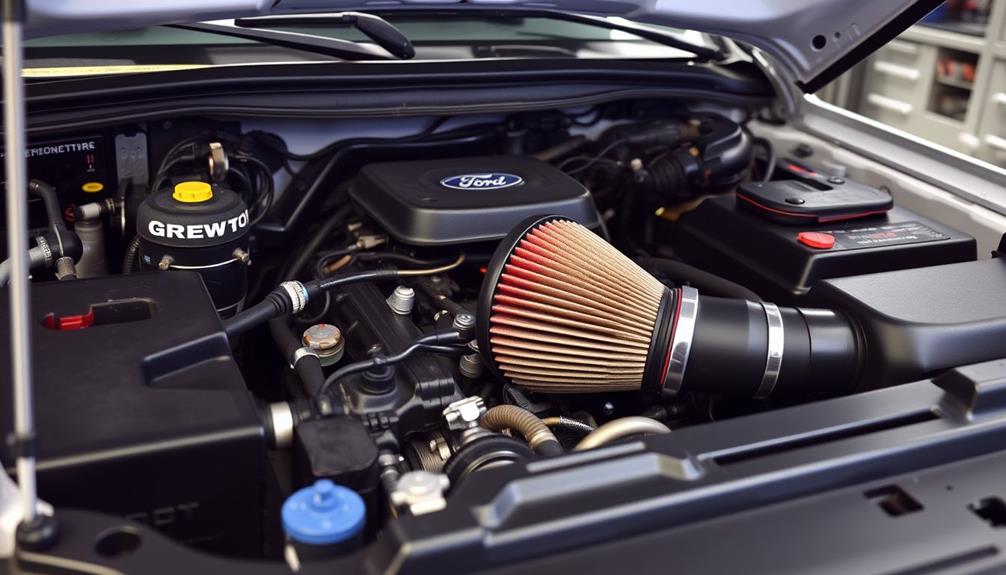
When you're ready to install a performance tune on your 2010 Ford Ranger, it's vital to follow a precise process to guarantee ideal results.
First, you'll want to enlist an ASE-certified mechanic to make sure the installation process goes smoothly. Typically, the tune installation takes about 30 minutes, requiring a Windows laptop for firmware updates.
Start by disconnecting the battery. You can expedite the initial PCM flash by using the headlights on/off method to reset the PCM.
Don't forget to adjust the tire size settings during this process; accurate speedometer readings are important after tuning.
After the performance tune is applied, allow some idle time for the PCM to adjust the air-fuel ratios. If the engine runs smoothly at idle, it indicates a successful learning process.
Keep in mind that while a limited warranty of 3 years/36,000 miles is offered, installing a tune may void the original equipment warranty on affected parts.
Frequently Asked Questions
Can a Ford Ranger Be Tuned?
Yes, you can tune a Ford Ranger using aftermarket tools. Customizing engine parameters enhances performance, potentially increasing horsepower and torque. Just remember to check warranty implications and consult a qualified mechanic before you start.
How Much HP Can a Ford Ranger Make?
Your Ford Ranger can produce between 143 to over 200 horsepower, depending on the tuning and modifications you choose. Upgrading components like the ECU, intake, and exhaust system greatly boosts performance and power output.
Is It Worth Remapping a Ford Ranger?
Imagine revealing a hidden treasure; remapping your Ford Ranger can boost horsepower and torque, enhancing performance. If you're after better acceleration and improved fuel efficiency, it's definitely worth considering—just mind your warranty!
How Much Horsepower Does a 2010 Ford Ranger 2.3 Have?
The 2010 Ford Ranger 2.3L engine produces 143 horsepower at 5,000 RPM. Its four-cylinder design offers a reliable balance of efficiency and power, making it suitable for everyday driving tasks and light hauling.
Conclusion
In summary, tuning your 2010 Ford Ranger can truly release its potential, making it feel like a turbocharged rocket in a world of ordinary pickups. By adjusting the speed limiter, tweaking the engine and transmission, and exploring cost-effective modifications, you can enhance performance without breaking the bank. Remember, just like upgrading an old flip phone to a smartphone, investing in the right tuning tools can transform your driving experience. So, hit the road and enjoy the ride!
